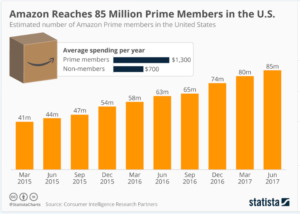by scott.gillum | Oct 12, 2017 | 2017, Entrepreneurship
 Something odd happened the other day on my morning run. Deciding to ramp up my training, I grabbed my Garmin GPS watch and headed out. The goal was to track my pace at various points on my usual route and that’s when I noticed a strange trend. At first, I thought my watch needed a software update because something really unusual was happening.
Something odd happened the other day on my morning run. Deciding to ramp up my training, I grabbed my Garmin GPS watch and headed out. The goal was to track my pace at various points on my usual route and that’s when I noticed a strange trend. At first, I thought my watch needed a software update because something really unusual was happening.
According to my watch, my pace running uphill was faster than when running downhill or on a flat stretch. Spending the remaining part of my route trying to figure why my natural pace didn’t fit the norm, I concluded that it was most likely the result of growing up at the bottom of a mountain. All of the excitement in the neighborhood was always happening at the top. During the summer, I’d run or ride my bike a mile and a half up a steady incline as fast as I could to get to the action — often several times a day. Going uphill, for me, always had its reward.
These last few months I’ve been on a personal journey searching for “what’s next.” I have spent a great deal of time speaking with former clients, colleagues, and friends. Our conversations focused on learning about their career paths. We talked about turning points, dead ends, and U-turns along their journeys. It was incredibly enlightening and helpful. Surprisingly, I also learned something else…
The people I spoke with, although mostly satisfied with their current status, longed for something better. When I explored “better” several themes were reoccurring; a better work/life balance, greater purpose in their work, freedom to work on things they were passionate about, etc. Interestingly, it was not isolated to one workforce generation, i.e. Millennials. Then I had a thought… do companies realize that there has been a change in the way people want to work? And, it seems to be universal. I heard the feedback, but had they recognized or responded to this shift?
Running parallel to this exploration, a couple of former clients approached me to do some consulting work. The companies we worked with had products and/or services that were considered to be “disruptive innovation.” There is a certain element of a “fear factor” to this new wave of technology, in particular, AI and robotics. The reality is they also have the opportunity to dramatically improve people’s lives. Unfortunately, that message hasn’t been well communicated, or received. One thing is certain, though, the last wave of technology was about business model disruption (think Netflix, Uber, AirBnB, etc.). The new wave is about personal disruption, for better or worse, depending on your viewpoint.
Similarly, my own journey came to the crossroads of personal disruption and a longing for something better. It got me thinking. Could an organization aimed at helping companies bring life-changing innovation to market be built on a business model that changed the life of the people it employed? From disruption, could something better be created? After circling back to many of the people I spoke with earlier, I concluded that it most definitely could.
And so, at this point in my life and career, when I wish I was better at coasting on flats or running downhill — I’ve picked another hill to run up. The grind, unfortunately, seems to suit me. Leaning into the incline gives me a feeling of purpose. The pounding heart and aching legs focus my mind, challenges my body and gives me a sense of accomplishment and clarity.
I also recognize (sadly) that I’m not as young as I once was, and to be successful in this new venture I will need the boost of friends and family to make it up the hill. I may not be able to run it as often, or as fast, so I’ll also need others to take the journey with me. I know the excitement is still at the top and getting there, although challenging, definitely has its rewards.
My life has and will continue to be disrupted, but I see something better coming…and so will you soon.
Follow the Carbon Design Co LinkedIn page to watch the journey to the top.
by scott.gillum | Sep 14, 2017 | 2017, Observations
They’re referred to as the “Duopoly” of online advertising. Facebook and Google account for 75% of the US digital ad spend and almost all of its growth according to Interactive Advertising Bureau (IAB). Facebook reported 45% growth in the last quarter and Google’s parent company, Alphabet posted earnings of $26 billion, 87% coming from advertising revenue.
But are these behemoths about to blindsided by a fierce competitor with a better ROI? We recently completed a consumer research study for a beverage manufacturer that uncovered an interesting trend, one that might tip the scale for advertisers.
Consumers, who had an Amazon Prime account, started their search for a purchase at Amazon 100% of the time. If they knew what they wanted to buy, they went directly to Amazon to search for different brands with the best price and delivery options.
With 85 million Amazon Prime members as of June 2017, it’s not going to take long for consumer brands to discover that if you want to invest ad dollars towards finding buyers with high purchase intent and conversion rates, Amazon is going to be hard to ignore. Although small in comparison to Google and Facebook, only 1% of global ads, it is one of Amazon’s fastest growing businesses, now on track to generate close to $2 billion this year.

Amazon also offers organizations a broad spectrum of advertising products ranging from their ad platform, offering mobile and desktop display and banner ads, to dynamic and coupon ads. Customer campaign pages allow advertisers to create immersive cross platform landing pages which can display more than one product.
With the digital ad market predicted to grow at 16% this year to $83 billion the “Duopoly” will get their fair share, and almost all of the attention, especially considering the growth of Facebook’s Snapchat ad revenue, up 158% in the past year. And that may be just how Amazon likes it. Having a history of sneaking up on competitors…just ask Microsoft and IBM about Amazon Web Services (AWS).
Andy Jassy, the AWS CEO said that in some ways the growth of his business was a classic case of disruption dynamics. “The competition simply didn’t believe there was enough of a market to worry about it. The dominant players don’t have any reason to worry about someone attacking the bottom of the market.” AWS now owns a third of the Cloud Infrastructure Services market, more than three times that of its next closest competitors.
Amazon seems to follow Al Pacino’s “never let them see you coming” advice from the Devil’s Advocate but one executive, Martin Sorrell, WPP CEO’s has noticed. Sorrell in a recent interview with Bloomberg said, “The company that would worry me if I was a client – or I think worries our clients, more than Google and Facebook – is Amazon.” Smart ad dollars follow consumer behavior and from we just learned, those consumers, are headed to Amazon.
by scott.gillum | Aug 16, 2017 | 2017, Marketing
 We’ve all had those trips. An important business meeting takes you to a new city, perhaps on your bucket list, and all you see is the airport, skyline and a conference room. Here are some thoughts on how to get the most out of your business trip in 5 popular cities.
We’ve all had those trips. An important business meeting takes you to a new city, perhaps on your bucket list, and all you see is the airport, skyline and a conference room. Here are some thoughts on how to get the most out of your business trip in 5 popular cities.
- Take A Train that Feels like a Boat Ride – skip the flight and take the Acela from New York to Boston. The views along the coast are fantastic and the stretch of track along the Connecticut coastline is stunning. The train literally crosses three beaches and there is a section around New London, CT that you will be over so much water, for so long, only a few feet above it, that it feels like you’re on a boat. Do it soon because they’re talking about rerouting the train to increase speed between the cities, that would move it off the shoreline.
- Balance the Bad with the Good in San Fran – too many trips result in hours of sitting in a windowless room all day eating crappy hotel food. To do that in a city like San Francisco is downright criminal. Here’s how to get the best out of a bad situation. If you can, avoid the conference hotel and book a room at the Harbor Court Hotel or Hotel Vitale on Embarcadero, near the Ferry Building. Counter balance the high calorie, low nutrition hotel food, by going for a run. Start across the street at the Ferry Building and head north to Fisherman’s Wharf, just listen for the harbor seals. Go south (right facing the building) and you can run around AT&T Park. Not a runner? No worries. Connected through a door from Harbor Court is the YMCA with a pool on the second floor, yoga & spin classes, etc. If you stay at the Hotel Vitale, book a soaking tub under the stars at the roof top spa to work out the kinks from sitting all day. You’re also at the right spot for great restaurants. Skip the conference dinner and head to the Ferry Building for seafood at Hog Island Oyster Co, or an organic vegan meal at The Plant Café If you have to eat at the conference, push the food around on your plate like a 5-year-old staring down lima beans, and then take the side exit for tapas at Michael Chiarello’s Coqueta on Pier 5.
- Experience Las Vegas Sans Casinos – ah, the Vegas conference scene, three days of non-stop overstimulation. Here’s a survival plan. Stay at the Elara. It’s on the strip, but adjacent to the Miracle Mile shops. The best part, great location, no casino…no noise, it’s an oasis from the onslaught. As for things to do off the strip, check out The Auto Collections at the LINQ Hotel & Casino…off the beaten path and a little hard to find (it’s on the top floor of the parking garage). The collection features Elvis’s Cadillac Limo and several cars from movies, including the original “Herbie The Love Bug” and several cars from “Gone in 60 Seconds.”
- Do Europe in a Weekend by Extended Your Stay in DC –this one takes a little (or a lot) of imagination. Fly into and out of Dulles Airport (IAD). Book a car at the airport on Friday and head to the “French” countryside and stay at the Hillbrook Inn in Charles Town, WV. Hillbrook was built by Brigadier General Frank E. Bamford, on land George Washington once owned. General Bamford modeled his home after an inn he loved in Normandy, where he stayed after WWI. Around the corner is “LeMans”, (Summit Point Motorsports Park) where you can watch a race or schedule some track time with your rental (I’ll never tell). In the afternoon head to “Monte Carlo” (Hollywood Casino) and do some gambling. From there it’s off to “Germany” in Shepherdstown, WV. Book Saturday night at the Bavarian Inn overlooking the Potomac river. The following day walk to “Transylvania” and spend the day in the town called the “Most Haunted Town in America” and subject of the Destination America TV series, “Ghost of Shepherdstown.” Or skip town and head back towards the airport, stopping in the historic town (and National Park) of Harpers Ferry (a 20-minute drive). Make your way back to Dulles, via Route 9, traveling through the “French Wine Country” region of Northern Virginia. You’ll pass 8 vineyards during the short journey (less than 30 minutes) back to the airport. If you’re running short on time, all the locations listed above are within an about hour of the airport.
- Book a Room With a Stunning View in NYC – no doubt there is a lot to see on the NYC skyline. Here are two you might not think of but provide Instagram worthy views. The first is the INK 48 hotel in Hell’s Kitchen on 48th and 11th. The Press Lounge on the 16th floor offers an incredible view of the Hudson River and the city (in particular Times Square). In the Financial District, stay at the Millennium Hilton, and ask for a room facing the 9/11 Memorial for a stunning view of the new Oculus transit hub and the memorial park.
Business travel can be a necessary evil, but occasionally, it can have an upside if you plan ahead. If you have ideas on how to improve the travel experience, please share them in the comment section below.
by scott.gillum | Jul 20, 2017 | 2017, Observations
 There is a grocery store a few miles from my house. It’s small and older, at least thirty years in its current location. Usually, the shelves are poorly stocked with a limited selection compared to the newer stores surrounding it. Despite these facts, the store manages to stay in business which is somewhat hard to comprehend given the cut throat, low margin nature of the industry. It survives because it has a secret weapon.
There is a grocery store a few miles from my house. It’s small and older, at least thirty years in its current location. Usually, the shelves are poorly stocked with a limited selection compared to the newer stores surrounding it. Despite these facts, the store manages to stay in business which is somewhat hard to comprehend given the cut throat, low margin nature of the industry. It survives because it has a secret weapon.
His name is Andres. He’s a cashier and has been at the store for twenty plus years. Andres speaks five languages and knows most of the customers by name, typically, greeting them in their native language. He knows where everything is, or isn’t, and if it’s not there he knows when it will arrive. He is the store.
While some customers, like my wife, frequent the store because it’s convenient, and quick, as long as the item is on the shelve. The majority of the customers go because of Andres. The store is in an affluent international neighborhood with many retirees. These core customers have time to shop and chat with Andres. For them, a trip to the store is an experience, not an errand. I haven’t seen the numbers, but I would guess that the revenue per square foot is why it survives.
The interesting thing, having worked with B2B companies for the past twenty years, is that many of my past clients also have an “Andres.” His, or her name may be different, but their role inside their organizations are not unlike Andres. They know the customers, how to get things done, where the “dead bodies” are buried, and how to navigate the complexity of the organization. They are the company.
As organizations rapidly move to “digitalization” and look for AI to play a larger role in customer interactions, they need to consider the importance of these essential employees. Like the grocery store, there are customers who may be highly profitable that aren’t doing business with your company because it’s convenient or fast. They are and have been customers, because of the experience. And a good portion of that experience is shaped by the “Andres” of the organization.
As other grocery stores move quickly to eliminate cashiers, Andres’s store has no self-checkout or online store pickup. Management seems to recognize the importance of the shopping experience, which seems to make up for the lack of selection and inventory. As your organization moves toward the future, does the management team fully understand that not all customers are the same, or want the same things. They may also speak separate languages and while self-service may work well for some, others want the full experience, which may include a personal conversation with their “Andres.”
by scott.gillum | May 23, 2017 | 2017, Marketing
Marketers, channeling their inner Maverick (Tom Cruise’s character in ‘Top Gun’) often find themselves thinking “I feel the need, the need for speed” but are plagued by internal speed bumps and stop signs. Little do they know that buried in Jeff Bezos’ annual shareholder letter is an approach for helping them accelerate marketing efforts, and navigate past internal road blocks.
Working with hi-tech clients, I learned the necessity for quick execution. Pipelines must be filled, leads progressed and converted, and quotas achieved. IBM had two “mantras” when it came to accelerating marketing execution. The first was the rule of “70%” and the second was “Fail Fast.” Once you had roughly 70% o f what you needed (information, insight, etc.) to execute you then got into the market, letting the results refine your program and thus quickly course correcting. Built on the idea of the yield curve, the greatest gains in progress were made during the first 70% of effort, refining the remaining 30% being too costly and time consuming.
f what you needed (information, insight, etc.) to execute you then got into the market, letting the results refine your program and thus quickly course correcting. Built on the idea of the yield curve, the greatest gains in progress were made during the first 70% of effort, refining the remaining 30% being too costly and time consuming.
“Failing fast” was built on the idea of quickly testing “concepts” or theories. If IBM wanted to experiment with something new or different it would construct tests to quickly measure results to either scale or kill the program. These two guide points have influenced my thinking over the many years.
So it was interesting to see Jeff Bezos picking up on these same principals in his annual shareholder letter. Except he added his own twist. In his letter he warns of becoming a “Day 2” company. He defines Day 1 companies as obsessed with customers, skeptical of proxies, eager to adopt new external trends, and perhaps most importantly, their ability to make high velocity decisions. For him, Day 2 companies become static, quickly becoming irrelevant and out of business eventually. The key to staying in “Day 1” is the ability to move quickly, experiment patiently, accept failures, and “double down when you see customers delight.”
Bezos believes that there is no “one-size-fits-all” to decision making but rather “two-way doors” where decision can be reversed. Those decisions in his words use a “lightweight” process. It starts with what he phases as “disagree and commit.” Given the growing number of stakeholders in the decision-making process, could this be the secret marketers have been searching for to eliminate speed bumps?
As Bezos describes it, “If you have conviction on a particular direction even though there’s no consensus, it’s helpful to say, ‘Look, I know we disagree on this but will you gamble with me on it? Disagree and commit?’ By the time you’re at this point, no one can know the answer for sure, and you’ll probably get a quick yes.”
Giving the success of Amazon, this is a piece of advice we should all heed. For marketers, the key to making this approach work is “conviction.” It means doing your homework, having the facts to support your point of view, and the courage to take a risk. Going fast brings with it the risk of failure, but as Bezos states “being wrong may be less costly than you think, whereas being slow is going to be expensive for sure.”
And Mr. Bezos knows a thing or two about flying fast. On the day he released his annual shareholder letter, Amazon stock closed over $900, up 50% over the year. Need any more proof that this “maverick” got it right?
 Something odd happened the other day on my morning run. Deciding to ramp up my training, I grabbed my Garmin GPS watch and headed out. The goal was to track my pace at various points on my usual route and that’s when I noticed a strange trend. At first, I thought my watch needed a software update because something really unusual was happening.
Something odd happened the other day on my morning run. Deciding to ramp up my training, I grabbed my Garmin GPS watch and headed out. The goal was to track my pace at various points on my usual route and that’s when I noticed a strange trend. At first, I thought my watch needed a software update because something really unusual was happening.

 We’ve all had those trips. An important business meeting takes you to a new city, perhaps on your bucket list, and all you see is the airport, skyline and a conference room. Here are some thoughts on how to get the most out of your business trip in 5 popular cities.
We’ve all had those trips. An important business meeting takes you to a new city, perhaps on your bucket list, and all you see is the airport, skyline and a conference room. Here are some thoughts on how to get the most out of your business trip in 5 popular cities. There is a grocery store a few miles from my house. It’s small and older, at least thirty years in its current location. Usually, the shelves are poorly stocked with a limited selection compared to the newer stores surrounding it. Despite these facts, the store manages to stay in business which is somewhat hard to comprehend given the cut throat, low margin nature of the industry. It survives because it has a secret weapon.
There is a grocery store a few miles from my house. It’s small and older, at least thirty years in its current location. Usually, the shelves are poorly stocked with a limited selection compared to the newer stores surrounding it. Despite these facts, the store manages to stay in business which is somewhat hard to comprehend given the cut throat, low margin nature of the industry. It survives because it has a secret weapon. f what you needed (information, insight, etc.) to execute you then got into the market, letting the results refine your program and thus quickly course correcting. Built on the idea of the yield curve, the greatest gains in progress were made during the first 70% of effort, refining the remaining 30% being too costly and time consuming.
f what you needed (information, insight, etc.) to execute you then got into the market, letting the results refine your program and thus quickly course correcting. Built on the idea of the yield curve, the greatest gains in progress were made during the first 70% of effort, refining the remaining 30% being too costly and time consuming.




